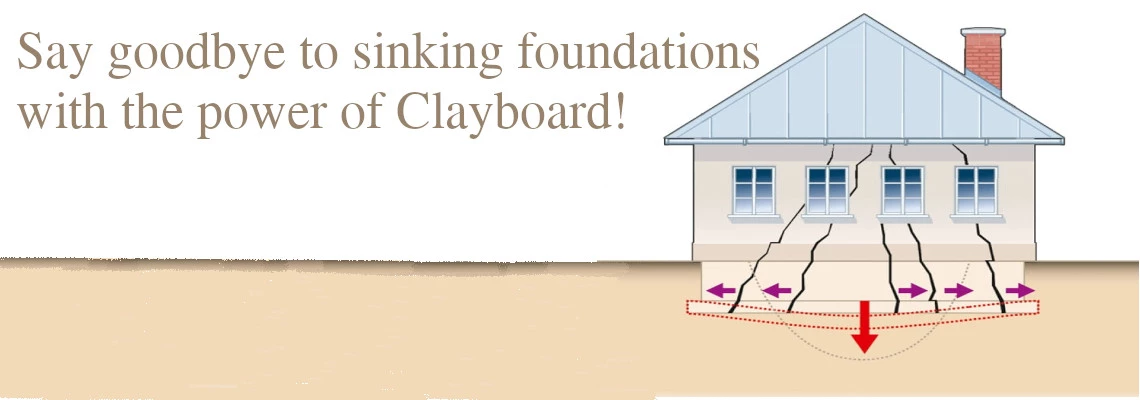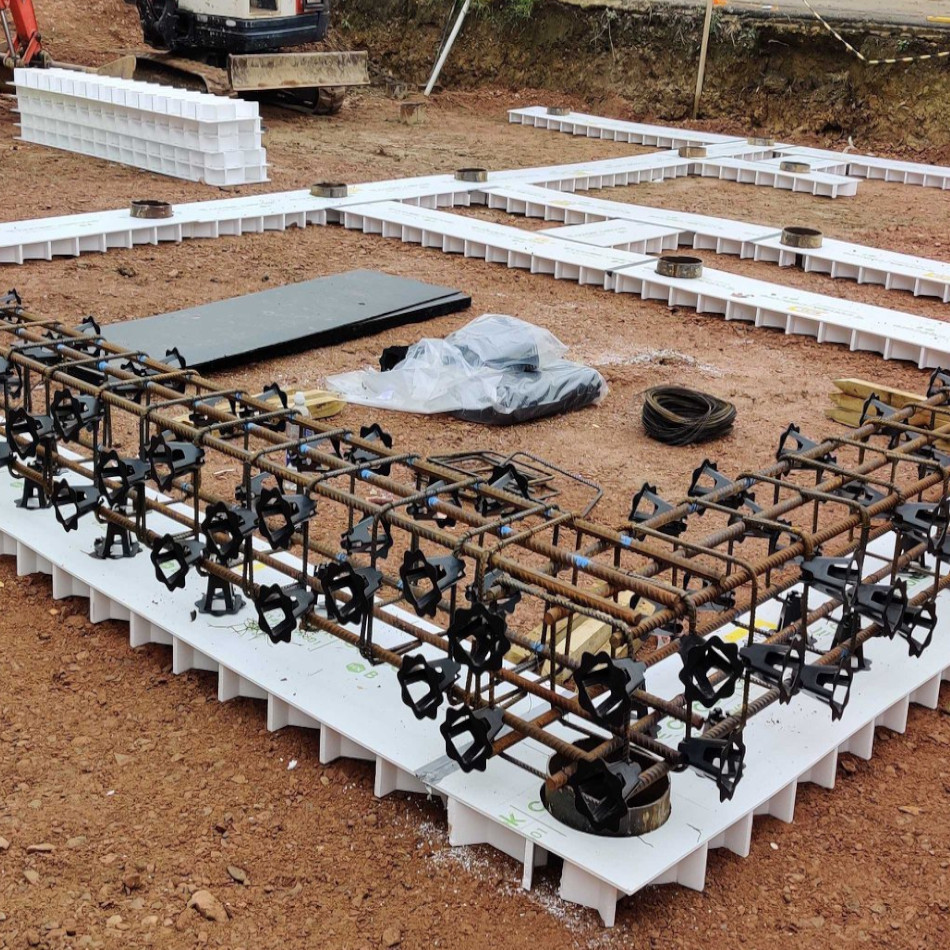
IS A CLAY BOARD UNDER CONCRETE ANY GOOD FOR FOUNDATIONS?*
When it comes to building a sturdy foundation for a structure, there are a lot of different materials and techniques that can be used. One method that some people have suggested is using a layer of clay board beneath the concrete. But is this actually a good idea? Let's take a closer look.
WHY USE CLAYBOARD IN FOUNDATIONS?
One of the main reasons why clayboard is used in foundations is to protect them from soil movement and settling. Clayboard simply provides a stable base for the foundation, which can help to prevent cracks and other forms of damage that can occur when the soil shifts or settles.
Overall, the use of clayboard in foundations can provide a number of benefits, including improved stability, and protection against clay.
When it comes to building a solid foundation, there are many factors to consider, including the materials and techniques used. One material that some builders may consider using in their foundation is Dufaylite clay board or Whiterock Heave stopper. To find out the differences click here.
Dufaylite clay board and its alternative product called Whiterock Heave stopper, is a type of board made from recycled paper that is used as a void former or heave protection layer in foundation construction. The board is designed to provide a stable base for concrete slabs and prevent heave or movement in the soil due to changes in moisture content.
One advantage of using both clay boards is its lightweight nature, which makes it easy to handle and install. It is also relatively affordable.
To find our what causes ground heave click here.

Picture credit: max-frank.co.uk
IS CLAY A GOOD BASE FOR CONCRETE?
Clay is not generally considered a good base for concrete in the UK, especially in London. This is because the geological map of the region clearly shows that it is one of the worst types of soil for building structures.
One of the main issues with clay as a base for concrete is its high water content. Clay has a tendency to expand and contract with changes in moisture levels, which can lead to instability and cracking in concrete structures built on top of it. In addition, the high plasticity of clay can make it difficult to achieve proper compaction, which is important for creating a stable foundation.
Furthermore, London's geology is characterised by layers of clay, sand, and gravel that were deposited by ancient rivers. The clay layers in particular are known for their poor load-bearing capacity, which can make them unsuitable for supporting heavy structures like buildings.
As a result, when building on clay soils in London, special care and precautions must be taken to ensure the stability and safety of the structure. This may involve using deep foundations or other techniques to distribute the weight of the structure over a larger area, or using alternative building materials that are better suited to the local soil conditions.
To find out what are the clayboard installation procedures click here.
CAN YOU PUT A FOUNDATION ON CLAY SOIL?
It is possible to put a foundation on clay soil, but it requires special care and preparation to ensure that the foundation remains stable over time. In general, clay soil has a high water content and can be prone to swelling and shrinking as moisture levels change, which can cause foundation movement and cracking.
One approach to building a foundation on clay soil is to use a collapsible or compressible void former, which is a type of material that is placed beneath the foundation to absorb any movement or settling in the soil. This can help to prevent the foundation from shifting or cracking over time.
There are several types of void formers that can be used, including expanded polystyrene (EPS) blocks such as Cellcore HX S (compressible void former) or even cardboard slabs such as Dufaylite clayboard (collapsible void former). These materials are typically lightweight and easy to handle, and they can be customised to fit the specific needs of the foundation design.

Picture credit: directpiling.co.uk
In addition to using a void former, it may also be necessary to take other measures to stabilise the soil and prevent foundation movement. This could include soil stabilisation techniques, such as soil compaction, or the use of drainage systems to control moisture levels in the soil.
Overall, building a foundation on clay soil requires careful planning and execution to ensure that the foundation remains stable and safe over time. The use of a void former can be an effective approach to help mitigate the risks associated with building on this type of soil.
HOW TO STABILISE FOUNDATION ON CLAY SOIL?
Stabilising a foundation on clay soil can be a challenging task due to the high water content. However, there are several techniques that can be used to help stabilise the foundation and prevent damage or failure over time.
- Soil stabilisation
One of the most effective ways to stabilise a foundation on clay soil is to stabilise the soil itself. This can be done using various techniques, such as soil mixing, or deep soil compaction. These methods work by altering the soil's properties to improve its load-bearing capacity and reduce its susceptibility to movement.
- Use a void former
A void former is a lightweight material that is placed beneath the foundation to absorb any movement or settling in the soil. This can help to prevent the foundation from shifting or cracking over time. Common materials used for void formers include expanded polystyrene ( slabs such as Cellcore HX S or Dufaylite clayboard or alternative Heave stopper. For more info click here.
- Install a drainage system
Poor drainage can contribute to soil instability and foundation movement. Installing a drainage system around the foundation can help to control moisture levels in the soil and prevent water from accumulating around the foundation.
- Choose an appropriate foundation type
Certain types of foundations are better suited to clay soils than others. For example, a pier and beam foundation can be a good option because it can be built on top of piers that are driven deep into the soil, bypassing the unstable clay layer. A shallow foundation, on the other hand, may be more susceptible to movement and cracking.
- Seek professional guidance
Stabilising a foundation on clay soil can be a complex and challenging process, and it's important to seek the guidance of a qualified professional. A geotechnical engineer or foundation specialist can assess the soil conditions and recommend the most appropriate stabilisation techniques for your specific situation.
Related articles:
HONEYCOMB VOID FORMER INSTALLATION GUIDE
160mm DUFAYLITE CLAYBOARD vs 160mm WHITEROCK HEAVE STOPPER
PROTECT YOUR HOME AGAINST CLAY SOIL
FOUNDATION HEAVE PROBLEMS. HEAVE SYMPTOMS
HEAVE PROTECTION TO FOUNDATION
*All the information provided in the content published on Insulationgo blog is for informational and educational purposes only. Insulationgo LTD makes every effort to ensure the accuracy and timeliness of the content, but we do not assume any responsibility for any errors or omissions.
The information presented on this blog should not be considered as professional advice or a substitute for consulting relevant experts. Before making any purchase decisions or taking action based on the information presented here, it is strongly recommended to contact the product manufacturer directly to verify the details and ensure its suitability for your specific needs.
By using this blog, you acknowledge and agree that Insulationgo LTD shall not be held liable for any damages, losses, or inconveniences arising from the use or reliance on the information provided herein. This limitation of liability applies to all users of the blog, including but not limited to visitors, readers, and subscribers.










































































































